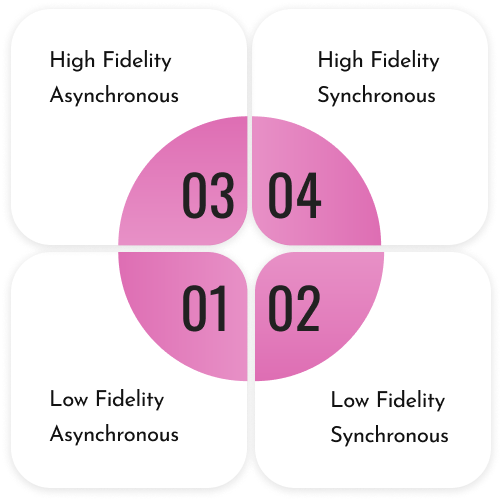A hybrid interview is just a regular interview, right?
Most people think a hybrid interview just means you do a video call first and then bring someone in for a live meeting as we always did.
But hybrid interviews open up a lot more questions that most teams are not ready to answer.
Do you need to change your interview style? How much should be in person? Is a telephone interview ok? Is it ok if everyone is at home? If we bring the candidate to the office, what if no one else is there? Do you change the questions that you ask?
Most importantly, a hybrid interview is the first opportunity for a candidate to see and understand your company’s approach to remote work. Being able to showcase your maturity to hybrid work can make the difference.
What is a hybrid interview?
A hybrid interview refers to a multi-step system for job interviews in which some of those interviews might be held remotely and others in person.
Best options for hybrid interviews
In the past, there was one way to do interviews. You told the candidate to come to the office at a particular time, and you did it live.
In the digital age, there’s suddenly a ton of options. They center around two axes.
- Synchronicity. This means if everyone has to participate at the same time or not. An email is asynchronous. A meeting at the office is synchronous.
- Fidelity. This means how many signals you have to communicate a message. A text message is very low fidelity. An in-person meeting is very high fidelity.
Here’s a nice grid:

Let’s look at each quadrant.
1. Low fidelity + Asynchronous
Examples
- Sending an email with a list of questions
- Online forms
- Assignments
Why it’s a great option
It allows you to scale your intake very quickly. You can process a lot of candidates all at once if you have a standardized form to look through.
Much of digital work falls in this category — chat messages, emails, and data. You’ll get a quick sense if someone is a great communicator. You can weed out people quickly who won’t be a fit for how your team communicates.
Giving assignments early on in the process helps to focus on the potential outcome of the person and prevents natural biases that creep in. However, make sure you aren’t giving assignments early on that amount to try to extract free labor. For more tips about low fidelity async assignments, check out this podcast episode with Wes Winham.
These options allow slow processors to shine. If the role you are hiring for doesn’t demand real-time decisions, give candidates some time to come up with their best answer.
It also doesn’t require you to coordinate schedules with any managers. They can review the applications on their own time.
Low fidelity options usually leave a nice paper trail. If someone sends in a form, the next person to review the candidate sees the exact same form and any comments. Conversely, an audio, video, or live conversation may not be recorded and the next person can only go off the interpretation of someone else.
2. Low fidelity + Synchronous
Examples
- Live chats
- Phone calls
Why it’s a great option
Doing a live chat session with a candidate lets you see how they interact in a medium that your team likely uses all the time.
Phone calls are also a great way to add some fidelity and signals to pick up on, but still focus on the conversation and not worry about background visuals.
3. High fidelity + Asynchronous
Examples:
- Audio/video recordings
Why it’s a great option:
You can send the candidate several questions to answer, but ask them to record themselves giving the answers. This lets you see how they use their whole presence, but also lets them do as many edits as they want. In our podcast with Darrian Mikell, he emphasized how we undervalue audio as a medium and how much we can learn from it.
You can also share the questions over a recorded video to give a more personal feel to the discussion.
4. High fidelity + Synchronous
Examples:
- Video calls
Why it’s a great option
Video calls have been standard in hybrid interviews for a few years now. They are useful for getting a feel for how someone thinks on their feet, and making a certain level of interaction.
In person interviews
In person interviews have their place, too. One of the biggest challenges of a hybrid environment is building true connections with people. An in-person interview can help to clear up any misconceptions about an interviewer’s personality quickly. For example, some people appear more stiff on video.
Bonding and connection are more likely to happen in person, so this interview approach is best for high-level roles or people who are advanced well into the interview process. In these later stages, the in-person interview is just as much as convincing the employee this is the perfect team for them.
Live IRL interviews are reserved for a time when you really need to drill down and get to know someone. They are more useful if you’ve already judged their competence and communication skills. Meeting in real life can help ease interactions later and sets up the relationship for success.
Getting the most out of hybrid interviews
The point is that you’ve got a lot of options, and each one can fit a very specific use case.
At each step in a hybrid interview, ask, “What do we need to learn about this candidate?” and then decide on the best medium to gather that information.
If all you really care about is if someone can get the job done, then put more weight on asynchronous assignments. But if how your team functions together is vital, a live group chat is a great way to see how they interact with others. Think about how most of the work is done in your company and align most of the interview with that medium.
Questions to ask in a hybrid interview
Along with role-specific questions, here are some questions to ask
- What appeals to you about a hybrid work environment?
- What are the biggest communication challenges you’ve experienced in a previous role?
- What times of day are you most productive?
- Give some examples of how you think through how to communicate important information with your team.
The hybrid interview is your chance to shine
Along with finding a great candidate, the hybrid interview process is your chance to demonstrate how mature your approach to hybrid work is. If it seems scattered to a candidate, they might have second thoughts about how long your hybrid honeymoon will last. Here are some tips to keep things smooth.
- Use a scheduler to make interviewing easy
- Tell them in advance if they’ll need to complete an assignment or review something (such as a company’s blog or podcast)
- Be mindful of their current location and time zone issues
- Schedule time on your calendar before and after each interview call to review notes, resumes, or other materials
- Only take up as much time as needed. Don’t make someone book a one-hour block on your calendar if you know the preliminary hybrid interview chat is only 20 minutes
- Likewise, budget in enough time so they have a chance to ask questions.
- If someone will interview in person, make sure to provide an office tour
- If you are bringing a candidate to the office, ensure that other essential people are also in the office and that it doesn’t feel like a ghost town
- Share details around any firm hybrid work schedules the company is already using
Whether you’re fully remote now and intend to go to hybrid or you’re already leveraging a hybrid workforce, make sure your hybrid interviews set you and the candidate up for the best possible experience.
Photo by Yan Krukov from Pexels
A hybrid interview is just a regular interview, right?
Most people think a hybrid interview just means you do a video call first and then bring someone in for a live meeting as we always did.
But hybrid interviews open up a lot more questions that most teams are not ready to answer.
Do you need to change your interview style? How much should be in person? Is a telephone interview ok? Is it ok if everyone is at home? If we bring the candidate to the office, what if no one else is there? Do you change the questions that you ask?
Most importantly, a hybrid interview is the first opportunity for a candidate to see and understand your company’s approach to remote work. Being able to showcase your maturity to hybrid work can make the difference.
What is a hybrid interview?
A hybrid interview refers to a multi-step system for job interviews in which some of those interviews might be held remotely and others in person.
Best options for hybrid interviews
In the past, there was one way to do interviews. You told the candidate to come to the office at a particular time, and you did it live.
In the digital age, there’s suddenly a ton of options. They center around two axes.
- Synchronicity. This means if everyone has to participate at the same time or not. An email is asynchronous. A meeting at the office is synchronous.
- Fidelity. This means how many signals you have to communicate a message. A text message is very low fidelity. An in-person meeting is very high fidelity.
Here’s a nice grid:

Let’s look at each quadrant.
1. Low fidelity + Asynchronous
Examples
- Sending an email with a list of questions
- Online forms
- Assignments
Why it’s a great option
It allows you to scale your intake very quickly. You can process a lot of candidates all at once if you have a standardized form to look through.
Much of digital work falls in this category — chat messages, emails, and data. You’ll get a quick sense if someone is a great communicator. You can weed out people quickly who won’t be a fit for how your team communicates.
Giving assignments early on in the process helps to focus on the potential outcome of the person and prevents natural biases that creep in. However, make sure you aren’t giving assignments early on that amount to try to extract free labor. For more tips about low fidelity async assignments, check out this podcast episode with Wes Winham.
These options allow slow processors to shine. If the role you are hiring for doesn’t demand real-time decisions, give candidates some time to come up with their best answer.
It also doesn’t require you to coordinate schedules with any managers. They can review the applications on their own time.
Low fidelity options usually leave a nice paper trail. If someone sends in a form, the next person to review the candidate sees the exact same form and any comments. Conversely, an audio, video, or live conversation may not be recorded and the next person can only go off the interpretation of someone else.
2. Low fidelity + Synchronous
Examples
- Live chats
- Phone calls
Why it’s a great option
Doing a live chat session with a candidate lets you see how they interact in a medium that your team likely uses all the time.
Phone calls are also a great way to add some fidelity and signals to pick up on, but still focus on the conversation and not worry about background visuals.
3. High fidelity + Asynchronous
Examples:
- Audio/video recordings
Why it’s a great option:
You can send the candidate several questions to answer, but ask them to record themselves giving the answers. This lets you see how they use their whole presence, but also lets them do as many edits as they want. In our podcast with Darrian Mikell, he emphasized how we undervalue audio as a medium and how much we can learn from it.
You can also share the questions over a recorded video to give a more personal feel to the discussion.
4. High fidelity + Synchronous
Examples:
- Video calls
Why it’s a great option
Video calls have been standard in hybrid interviews for a few years now. They are useful for getting a feel for how someone thinks on their feet, and making a certain level of interaction.
In person interviews
In person interviews have their place, too. One of the biggest challenges of a hybrid environment is building true connections with people. An in-person interview can help to clear up any misconceptions about an interviewer’s personality quickly. For example, some people appear more stiff on video.
Bonding and connection are more likely to happen in person, so this interview approach is best for high-level roles or people who are advanced well into the interview process. In these later stages, the in-person interview is just as much as convincing the employee this is the perfect team for them.
Live IRL interviews are reserved for a time when you really need to drill down and get to know someone. They are more useful if you’ve already judged their competence and communication skills. Meeting in real life can help ease interactions later and sets up the relationship for success.
Getting the most out of hybrid interviews
The point is that you’ve got a lot of options, and each one can fit a very specific use case.
At each step in a hybrid interview, ask, “What do we need to learn about this candidate?” and then decide on the best medium to gather that information.
If all you really care about is if someone can get the job done, then put more weight on asynchronous assignments. But if how your team functions together is vital, a live group chat is a great way to see how they interact with others. Think about how most of the work is done in your company and align most of the interview with that medium.
Questions to ask in a hybrid interview
Along with role-specific questions, here are some questions to ask
- What appeals to you about a hybrid work environment?
- What are the biggest communication challenges you’ve experienced in a previous role?
- What times of day are you most productive?
- Give some examples of how you think through how to communicate important information with your team.
The hybrid interview is your chance to shine
Along with finding a great candidate, the hybrid interview process is your chance to demonstrate how mature your approach to hybrid work is. If it seems scattered to a candidate, they might have second thoughts about how long your hybrid honeymoon will last. Here are some tips to keep things smooth.
- Use a scheduler to make interviewing easy
- Tell them in advance if they’ll need to complete an assignment or review something (such as a company’s blog or podcast)
- Be mindful of their current location and time zone issues
- Schedule time on your calendar before and after each interview call to review notes, resumes, or other materials
- Only take up as much time as needed. Don’t make someone book a one-hour block on your calendar if you know the preliminary hybrid interview chat is only 20 minutes
- Likewise, budget in enough time so they have a chance to ask questions.
- If someone will interview in person, make sure to provide an office tour
- If you are bringing a candidate to the office, ensure that other essential people are also in the office and that it doesn’t feel like a ghost town
- Share details around any firm hybrid work schedules the company is already using
Whether you’re fully remote now and intend to go to hybrid or you’re already leveraging a hybrid workforce, make sure your hybrid interviews set you and the candidate up for the best possible experience.
Photo by Yan Krukov from Pexels
)
)
)







